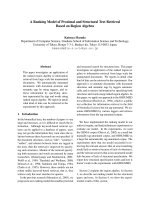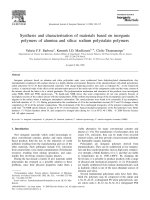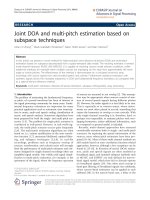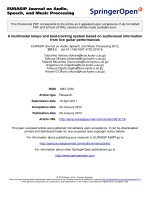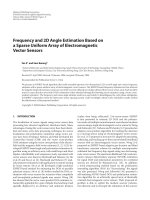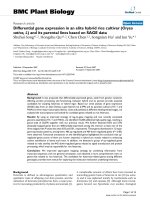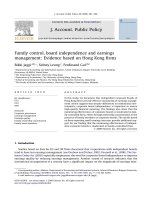Scalable and flexible photothermal material based on bacterial cellulose for solar steam generation
Bạn đang xem bản rút gọn của tài liệu. Xem và tải ngay bản đầy đủ của tài liệu tại đây (2.72 MB, 49 trang )
VIETNAM NATIONAL UNIVERSITY, HANOI
VIETNAM JAPAN UNIVERSITY
NGUYEN THI KIEU TRANG
SCALABLE AND FLEXIBLE
PHOTOTHERMAL MATERIAL BASED ON
BACTERIAL CELLULOSE FOR
SOLAR STEAM GENERATION
MASTER'S THESIS
VIETNAM NATIONAL UNIVERSITY, HANOI
VIETNAM JAPAN UNIVERSITY
NGUYEN THI KIEU TRANG
SCALABLE AND FLEXIBLE
PHOTOTHERMAL MATERIAL BASED ON
BACTERIAL CELLULOSE FOR
SOLAR STEAM GENERATION
MAJOR: NANOTECHNOLOGY
CODE: 8440140.11QTD
RESEARCH SUPERVISOR:
Dr. PHAM TIEN THANH
Hanoi, 2021
ACKNOWLEDGEMENT
Firstly, I'd want to express my gratitude to Dr. Pham Tien Thanh, one of my supervisors
at Vietnam Japan University, for his excitement, support, and patient guidance
throughout the preparation of my master thesis.
I'd want to take this opportunity to thank Dr. Nguyen Hoang Duong and Dr. Nguyen
Duc Cuong for their assistance. Their suggestions have been quite useful in my research.
I also thank all member of MNT Lab and MEE Lab for helping and supporting me in
my lab works. I really enjoy and appreciate not only researching but also around time
here.
Last but not least, I really want to thank to MNT’s lectures for their support me during
the internship period. Without them, I could not have enough knowledge and experience
to research and study in here.
I want to express my gratitude to my mother, father, brother, and friends, who have
always been there for me and have always supported and encouraged me throughout my
life.
This work is fully supported by the project with the code number of VJU.JICA.21.03,
from Vietnam Japan University, under Research Grant Program of Japan International
Cooperation Agency.
Nguyen Thi Kieu Trang
Hanoi, 2021
TABLE OF CONTENTS
LIST OF TABLES........................................................................................................... i
LIST OF FIGURES ........................................................................................................ ii
LIST OF ABBREVIATIONS ....................................................................................... iv
CHAPTER 1: INTRODUCTION ....................................................................................1
1.1.
Clean water issue ...............................................................................................1
1.2.
Solar steam generation .......................................................................................2
1.2.1.
Design of solar steam generation (SSG) .....................................................3
1.2.2.
Photothermal materials ................................................................................3
1.3.
Purpose of thesis ................................................................................................7
2. CHAPTER 2: EXPERIMENTAL METHOD ..........................................................8
2.1.
Fabrication of photothermal material.................................................................8
2.1.1.
Fabrication of bacterial cellulose (BC) .......................................................8
2.1.2.
Fabrication of photothermal material ..........................................................8
2.2.
Characterization of photothermal materials .......................................................9
2.3.
Solar steam generation systems .......................................................................10
2.3.1.
Construction SSG system ..........................................................................10
2.3.2.
Evaluate the water evaporation ability of SSG system .............................11
3. CHAPTER 3: RESULTS AND DISCUSSION .....................................................14
3.1.
The surface morphologies of BTF materials ...................................................14
3.2.
The surface structure of BTF materials ...........................................................17
3.2.1.
FTIR ..........................................................................................................17
3.2.2.
XRD and EDS ...........................................................................................18
3.2.3.
Iron-tannic acid complexes .......................................................................20
3.3.
The photothermal materials: BTF ....................................................................21
3.3.1.
Absorption .................................................................................................21
3.3.2.
Thermal conductivity ................................................................................22
3.3.3.
Contact angle .............................................................................................23
3.3.4.
Evaluation of light to heat conversion ......................................................23
3.4.
Performance of SSG system ............................................................................25
3.4.1.
SSG system under solar simulator ............................................................25
3.4.2.
SSG system under natural sun condition ..................................................29
3.4.3.
Stability of photothermal material BTF ....................................................30
3.4.4.
Self-cleaning property ...............................................................................31
3.4.5.
Quality of freshwater collected from SSG ................................................32
4. CONCLUSION .......................................................................................................36
REFERENCES ..............................................................................................................37
LIST OF TABLES
Table 3.1 Composition of BC, BC-TA and BTF...........................................................19
i
LIST OF FIGURES
Figure 1.1. (a) Distribution of water on the Earth [6], (b) saline intrusion warning in
the Mekong Delta [30]. ....................................................................................................2
Figure 1.2. Metal nanoparticle [31]. ................................................................................4
Figure 1.3. CuFeSe2 NPs - decorated wood membrane for solar steam generation [19].
.........................................................................................................................................5
Figure 2.1. Bacterial cellulose fabrication process. .........................................................8
Figure 2.2. Preparation of photothermal material. ..........................................................9
Figure 2.3. Some instruments in this study. (a) JSM-IT100 InTouchScopeTM
Scanning Electron Microscope (b) Oriel® Sol1ATM Solar Simulators (c) FLIR C2
Camera (d) X-ray Diffraction (XRD Mini Flex 600) (e) UV-VIS Lambda 950 . ........10
Figure 2.4. The structure of steam generation part of SSG system. ..............................11
Figure 2.5. Evaluating the steam evaporation index of SSG in the laboratory condition.
.......................................................................................................................................12
Figure 2.6. The experiment of collecting purified from seawater of SSG system. .......12
Figure 3.1. Images of BC growth in 5 days. ..................................................................14
Figure 3.2. The change of materials during the fabrication of photothermal materials.
.......................................................................................................................................15
Figure 3.3. SEM images of BC and BTF materials. ......................................................16
Figure 3.4. BET of BC...................................................................................................17
Figure 3.5. FT-IR spectra of BC and BTF materials show difference of peak. ............18
Figure 3.6. XRD spectra of BC and BTF materials show slightly changes in the
diffraction peaks. ...........................................................................................................19
Figure 3.7. Schematic representation of cellulose with hydrogen bonded tannic acid. 20
Figure 3.8. The possible complexation mechanism of TA with Fe3+. ...........................20
Figure 3.9. Absorption spectra of the BC and BTF in dry/wet condition. ....................22
Figure 3.10. Thermal conductivity of BTF. ..................................................................22
Figure 3.11. Contact angle of BTF. ...............................................................................23
Figure 3.12. The maximum temperatures of BC and BTF materials ............................24
Figure 3.14. The mass changes in seawater evaporation under dark condition ............26
Figure 3.15. The maximum temperatures of BC and BFT materials based SSG surface
.......................................................................................................................................27
Figure 3.16. Infrared photos of the BTF based SSG surface during evaporation
process. ..........................................................................................................................27
Figure 3.17. The evaporation rate of BTF with different thickness under 1 sun. .........28
Figure 3.18. Mass change of functionalized material under natural sun. ......................29
Figure 3.20. Cycling stability of the SSG system under 1 sun illumination with
60minutes irradiation for each cycle. ............................................................................31
ii
Figure 3.21. Self-cleaning process of BTF material with the salt mas of 2 g. ..............31
Figure 3.22. Mechanism of self-cleaning process of BTF. ...........................................32
Figure 3.23. The steam condensed on the glass and flowed down to the water tank ....33
Figure 3.24. The volume of purified water from SSG system. .....................................34
Figure 3.25. The electrical resistances of seawater, desalinated water and
domestic water. ..............................................................................................................35
iii
LIST OF ABBREVIATIONS
AuNPs
Gold nanoparticles
BC
Bacterial cellulose
BTF
BC-TA-Fe3+
BET
Brunauer–Emmett–Teller
EDS
Energy Disperse X-Ray Spectroscopy
FTIR
Fourier-Transform Infrared Spectroscopy
LSPR
Localized surface plasmon resonance
NPs
Nanoparticles
SEM
Scanning Electron Microscope
SSG
Solar steam generation
XRD
X-ray powder diffraction
iv
1. CHAPTER 1: INTRODUCTION
1.1.
Clean water issue
Water comprises 70% of our planet, and it's safe to assume that water will continue to
be plentiful. On the other hand, soft drinks, which we consume on a daily basis, are quite
rare. Fresh water accounts for only 2.5% of the total water available on earth, which will
not be enough to meet the needs of the world's growing population. By 2050, water
demand is expected to rising by 400% and 130% from industrial and residential
consumption, with more than 40% of the world's population facing extremely water
shortages [5]. About 1.1 billion people do not have access to clean water, out of a total
of 2.7 billion people experience water scarcity for at least one month of the year. Rivers,
wetlands, and aquifers are drying up or becoming unusable due to pollution. About half
of the world's wetlands have been lost. Agriculture uses the most water of any source
and loses a significant amount of water due to inefficiency. Climate change is altering
weather and water patterns all over the world, resulting in water shortages and droughts
in some places and flooding in others [17]. In terms of the atmosphere, water scarcity
on Earth is manifested by negative environmental phenomena such as rising salinity and
shrinking fresh water supplies on the land surface, such as lakes, rivers, and ponds [16].
Vietnam is the world's 13th most populated nation, with nearly two-thirds of the
population living along the country's three major river basins: Thai Binh, Mekong Delta,
and Dong Nai. In the Mekong Delta, the extent of saline intrusion in these rivers has
been deeper than the same period in 2016 by about 3 to 11 km. The phenomenon of
saline intrusion in the Mekong Delta affects not only agricultural production but also
water supply and living conditions for millions of coastal people [29]. Protecting the
climate, biodiversity, and communities on Earth requires developing strategies to reduce
the rise in water scarcity. To alleviate water shortage, various solutions have been
suggested, such as improving water filtration systems, encouraging water conservation...
Among these options, the use of freshwater processing technology from seawater has
gotten a lot of attention in recent decades. An applied technology's main value is
improving seawater metabolic efficiency while lowering energy consumption.
1
One of the most common procedures for converting seawater to freshwater is
desalination. Many technologies have been developed and applied, including distillation,
ion exchange, and membrane filtering... [4,15]. However, these technologies have
limitations, including expensive costs, excessive material consumption, and poor
performance due to salt precipitation and seawater corrosion. The technology of
producing clean water from seawater using solar energy is attracting a lot of attention
today. This technology has the potential to build an environmentally sustainable, lowcost, high-performance device [19,22,23].
Figure 1.1. (a) Distribution of water on the Earth [6], (b) saline intrusion warning in
the Mekong Delta [30].
1.2.
Solar steam generation
Solar energy is a renewable and limitless source of energy. The potential for solar energy
is huge, as the Earth receives about 200,000 times the world's total daily electricity
production in the form of solar energy every day. Unfortunately, despite the fact that
solar energy is free, the high costs of collection, conversion, and storage limit its use in
many ways. Solar energy can be converted into thermal energy or electrical energy
applied in people's daily life [2].
Vietnam is one of the countries with the highest number of sunshine hours in the world.
This is a great situation, giving Vietnam a number of advantages when it comes to
installing solar-powered equipment. Solar steam production has become one of the most
essential ways of water desalination as it utilizes the abundant solar energy to produce
clean water. Clean water is obtained by passing the steam via the condenser device. The
2
SSG system has a number of benefits, including eco-friendly, zero CO2 emissions, easy
installation, and low cost. With 6-7 hours of sunlight per day, as in the south of Vietnam,
a typical appliance can generate from 15 to 30 L/h, which is equal to a household's daily
minimum water demand [34].
1.2.1. Design of solar steam generation (SSG)
Solar steam generation (SSG) is a technology that uses the photo-thermal effect to
produce freshwater from seawater. The SSG is used in a variety of applications such as
desalination of seawater, purification of wastewater, and photothermal steam
sterilization. Three basic components make up a solar steam generation system: (1)
photothermal material, (2) water supply device, and (3) a container for freshwater. The
conversion of solar energy to thermal energy is the principle of the SSG system. The
photothermal material absorbs photons and converts light energy into heat in this
process. A sufficient amount of heat is needed for water (in liquid form) to evaporate
into a high-purity vapor. After that, the vapor condenses and is stored in a storage tank.
Water is continuously transferred to the surface of the photothermal material in the SSG
system by several mechanisms, one of which is capillary path. The SSG system is
expected to solve the shortage of clean water caused by global warming due to
photothermal materials that generate heat from solar energy without emitting CO2.
Many research groups have produced photothermal materials for SSG systems to
improve freshwater yield. Many different types of materials have been utilized to
fabricate photothermal materials for SSG system which can absorb higher than 90 % of
sunlight such as metal nanoparticles [11,31], semiconductors [33,19] and polymers [10].
1.2.2. Photothermal materials
In order to efficiently convert sunlight into heat, photothermal nanomaterials for SSG
must meet the following requirements: High broad-spectrum absorption capacity of
solar wavelengths in the solar spectrum ranging from 300 - 2500 nm. Solar energy
converts to heat efficiently and has a low rate of heat loss to the surrounding
environment. Moreover, due to the excellent physical characteristics: small size and
large specific surface, nanomaterials have a competitive advantage in the conversion of
light into heat.
3
Many different types of materials were used to fabricate photothermal materials that are
generally classified into four categories as follows: photothermal materials from (1)
metal nanoparticles, (2) semiconductors, (3) polymer materials, (4) natural materials
that the main component is cellulose.
Metal nanoparticles are the first photothermal materials. The plasmonic resonance of
metal NPs can efficiently scatter, trap and absorb light over a wide spectrum after
thermal formation by non-radiative damping after sunlight absorption. Under the
influence of light, the free electrons of these nanoparticles oscillate in the metal lattice;
These oscillations resonate at a specific frequency of the incident light. Localized
surface plasmon resonance (LSPR) is the name for this form of resonance. The absorber
layer was made of a variety of metals with nanostructures, including gold, silver, and
copper. Zhenhui has developed an SG system consisting of a self-assembled film of gold
nanoparticles that can be used to pump water from bulk to the evaporator surface by
capillary action and localized heat on the surface evaporated through plasmonic heating
[31]. The resulting film is capable of floating in water. The plasmonic film is made up
of gold nanoparticles (AuNPs) that convert the absorbed optical light into heat, creating
bubbles around the particles. These bubbles burst at the interface of water and air,
generating heat. Thermal localization improves the efficiency of heat-to-evaporation
conversion by limiting heat loss to the water mass. Self-assembled membranes are
manufactured with a solar thermal efficiency of 40% at 1 sun. Fang and colleagues
created a solar-powered SG system by chemically coating silver/diatomite and placing
it on filter paper attached to foam-coated air-buffer paper. polystyrene is a type of plastic.
The evaporation rate is 1.39 kg m-2 h-1. At 1 sun, the evaporation efficiency is 92.2%.
Figure 1.2. Metal nanoparticle [31].
4
Non-radiative semiconductor relaxation is the second class of photothermal materials.
Light is absorbed by the semiconductor material to transfer electrons from the valence
band to the conduction band. Until returning to the valence band, electrons perform outof-order expansion in the conduction band. The temperature of the material increases
due to this expansion, promoting evaporation. Hu's group has developed a highperformance SSG application film with a narrow band semiconductor 0.45 eV made of
wood embellished with CuFeSe2 NPs (encoded as black wood films) in 2018. [19].
Irradiated under 5 kWm-2, CuFeSe2 NPs decorative wood films achieve higher
performance solar thermal characteristics 86.2% as well as a neutral structure, low
density, localized heat, low thermal conductivity, high hydrophilicity and low cost.
Figure 1.3. CuFeSe2 NPs - decorated wood membrane for solar steam generation [19].
The third type of photothermal materials are polymers. Popular polymers such as
polydopamine and polyacrylamide have been used as sunlight absorbers because of their
low cost, good biodegradability and environmental friendliness. Jia's team demonstrated
the ability to produce a new, cost-effective, scalable and high-performance bilayer
photothermal material based on attapulgite/polyacrylamide (APAC) composites. The
dual-layer APAC has a high vapor ratio of 1.2 kg m-2 h-1 when exposed to one sun,
which equates to a solar vapor efficiency of 85%. Liu introduced a biomass-geopolymercarbon-neutral synthesis (GBMCC) device with neutral and macroscopic structure for
solar energy harvesting. The GBMCC device achieves water evaporation rates of 1.58
and 2.71 kg m-2 h-1 under sunlight 1 and 3, respectively, with a solar heat conversion
efficiency of 84.95 % and 67.6% [19].
5
These photothermal materials have super hydrophilic properties, a porous structure, a
capillary mechanism that allows water to evaporate rapidly enough on the surface, and
a low heat transfer coefficient that reduces heat loss to the environment [10,11,12,28,33].
Besides, the materials had low thermal conductivity, which limited the conduction heat
to the surrounding environment [36]. As a result of these factors, SSG systems made
from the above materials have a high evaporation rate under 1 sun condition. However,
implementing SSG systems based on the above materials in practical systems on a large
scale still faces numerous challenges, including (1) a complex fabrication process that
is difficult to scale up, (2) a high cost, (3) low reliability of the materials that are not
suitable for transport and commonly used in various practical situations, and (4)
materials from metal, polymer can cause environmental pollution [12,28,36].
Bacterial cellulose (BC) is versatile material composed of cellulose fibers having size
in range of 100–200 nm that form a three-dimensional scaffold, which has shown
remarkable high Young's modulus value, high water uptake capacity, great crystallinity,
tremendous degree of polymerization and having fibers with high aspect ratio [25,30].
The most notable properties of BC are the great porosity and huge total surface area.
Therefore, it is biocompatible material and thus suitable for sustainable fabrication
process, biomedical applications using BC composites [24,27]. In addition, the BC also
have significant advantages for photothermal materials, such as a low thermal
conductivity due to porous structure (to reduce heat loss), hydrophilic properties the
ability to quickly transfers water through the 3D network structures of BC. Many
research groups have used BC materials to fabricate photothermal materials that are
added to the evaporator device to filter seawater based on the above structure. Zhang et
al. (2020) present a versatile bi-layered bacterial cellulose (BC) biofoam evaporator, in
which the photothermal conversion layer is made of CuS/BC composite material, and
the water transport and thermal insulation layer is made of regenerated BC biofoam [35].
The optimal evaporation rate is 1.44 kg m-2 h-1 with an evaporation efficiency of 83.5 %.
The combination of bacterial nanocellulose (BNC) and polydopamine (PDA) exhibits
high light absorption and photothermal conversion, thermal localization, and effective
water transport, with a water evaporation efficiency of up to 78 % [14]. Under 1 sun
condition (1 kW/m2), the evaporation efficiency of the photothermal materials described
above will exceed 78-90 % in steam evaporation systems, and evaporation efficiency is
6
between 1.2-1.6 kg m-2 h-1. However, the application of their photothermal materials is
also challenged due to complicated fabrication processes that hinders large-scale
production. Therefore, there is an urgent demand for novel photothermal materials with
simple fabrication process and eco-friendly input materials.
1.3.
Purpose of thesis
The group's previous studies on natural photothermal conversion materials such as
pomelo, fingered citron or corn straw have shown positive results when applied to the
water evaporation system. However, the above materials are difficult to adjust in size,
so their application in nature is somewhat limited. BC is a material that is easily cultured
and can be adjusted in size depending on time, temperature, and culture medium. The
fabrication of SSG structures using bacterial cellulose (BC) to prepare photothermal
materials is described in this thesis. An iron-tannic complex has chemically
functionalized the natural porous content, providing good absorption in the solar field.
Thermal imaging measurements are used to assess the conversion of energy from
absorbed solar radiation into heat on the material's surface. Calculating the water
evaporation rate in the solar simulator as well as under real-world conditions was used
to assess the efficiency of the fabricated SSG devices. The portability of fresh water is
measured by determining the purity of the water using SSG instruments in real-world
conditions.
The master's thesis aims at:
-
Fabricating of photothermal materials from BC materials using a chemical
process.
-
Studying the characteristics of the materials.
-
Evaluating of the evaporation efficiency of SSG system based on the
photothermal material under laboratory condition.
-
Evaluating of the durability of the materials.
-
Demonstration of seawater desalination capacity of SSG system in real
conditions.
7
2. CHAPTER 2: EXPERIMENTAL METHOD
2.1.
Fabrication of photothermal material
2.1.1. Fabrication of bacterial cellulose (BC)
Figure 2.1. Bacterial cellulose fabrication process.
Green tea and boiling water were used to make the tea, which was then allowed to steep
for 20 minutes. After removing the tea bags, sugar was dissolved in the tea and allowed
Figure
2.2. Bacterial
cellulose
fabrication
process.
to cool to 37°C before
adding
the kombucha
Symbiotic
Colony
of Bacteria and Yeast
(SCOBY). After that, the sweetened tea containing the starting SCOBY was covered
with a cotton cloth and kept at 28°C in a dark cabinet. When the fresh kombucha BC
produced at the air–water contact reached the required thickness, it was carefully
collected. The collected kombucha BC is then immersed in a 1.0 M NaOH solution at
90°C for 1 hour. The BC is then immersed in aqueous sodium hypochlorite (NaOCl) for
2.0 hours at ambient temperature (23 °C). The BC was then taken from the NaOCl bath
and soaked in deionized water six times to completely remove the cleaning agent.
Finally, BC is kept at 4 °C in deionized water for future studies.
2.1.2. Fabrication of photothermal material
Chemicals
8
-
Chemicals used to fabricate photothermal materials included tannic acid
(C76H52O46; GHTECH; China) and Iron (III) chloride hexahydrate (FeCl3.6H2O;
GHTECH; China).
-
To make the solutions, ultra-pure water from the Water distill D4000 (VJU) was
utilized.
Process
Figure 2.3. Preparation of photothermal material.
0.8 g tannic acid was dissolved in 200 ml distilled water to make a tannic acid (TA)
solution with a concentration of 0.0023M. 0.4 g FeCl3 was dissolved in 200 ml distilled
water to make the 0.012M FeCl3 solution. The blackening process was procedured
through 2 main steps as shown in figure 2.2. First step: BC (5 mm in thickness, 4.5 cm
diameter) was immersed in TA solution and stir for 20 hours. Then, the samples were
rinsed with distilled water to remove free TA particles. Second step: BC-TA is dipped
in Fe3+ solution and stirred for 2 hours. After that, samples were rinsed with distilled
water to obtain photothermal material BC-TA-Fe3+.
2.2.
Characterization of photothermal materials
9
At Nanotechnology Laboratory, Vietnam Japan University, and Hanoi University of
Science (HUS), the photothermal materials were examined and their structure
investigated using some equipment (VNU). Figure 2.3 depicts some of the tools utilized
in this study. These devices were used to examine the photo-thermal conversion
materials' structural and morphological features.
Figure 2.4. Some instruments in this study. (a) JSM-IT100 InTouchScopeTM
Scanning Electron Microscope (b) Oriel® Sol1ATM Solar Simulators (c) FLIR C2
Camera (d) X-ray Diffraction (XRD Mini Flex 600) (e) UV-VIS Lambda 950 .
The surface structure of the BC pellicle was analyzed by Scanning electron microscopy
2.5. Some
instruments
in this
study. (a) JSM-IT100
(SEM;Figure
JSM-IT100,
JEOL
Ltd., Japan)
at accelerated
voltage of InTouchScopeTM
10kV. The scattering,
Scanning Electron Microscope (b) Oriel® Sol1ATM Solar Simulators (c) FLIR C2
transmittance and reflectance spectra of the material surface were measured from 300
Camera (d) X-ray Diffraction (XRD Mini Flex 600) (e) UV-VIS Lambda 950 .
nm to 2500 nm by infrared spectrometer (LAMBDA 950; Perkin Elmer, Inc; USA)
attached to an integrating sphere. The absorbance A is calculated according to the
formula A = 1 - R - T. Fourier-transform infrared spectrum (FTIR; FTIR-4600; JASCO;
Japan), Energy Disperse spectrum (EDS; JED-2300, JEOL Ltd., Japan) and X-ray
Diffraction pattern (XRD Mini Flex 600, Rigaku, Japan) was used to analyze the
chemical structure of BC pellicles and photothermal materials.
2.3.
Solar steam generation systems
2.3.1. Construction SSG system
10
The BC photothermal material was attached to the commercial polystyrene (thickness
of 15 mm) foam covered with a commercial cotton gauze (thickness of 0.2–0.3 mm;
mesh size of 2 mm 2 mm), as illustrated in Figure 2.4. The samples were floated in a
quartz beaker (4.5 mm in diameter) filled with water. At the Faculty of Engineering
Physics and Nanotechnology, VNU University of Engineering and Technology (VNUUET), water evaporation of SSG devices was studied using a solar simulator Oriel®
Sol1ATM under 1 sun irradiation (Power = 1 kW.m-2). Using a thermal imaging camera
(FLIR C2; FLIR Systems, Inc.; USA), the IR photographs of the samples were obtained,
and the corresponding temperature distributions were determined.
Figure 2.6. The structure of steam generation part of SSG system.
The structural model and actual image of the steam generator of the SSG system are
shown in Fig 2.4. The water supply is composed of two parts: a cup-filled reservoir and
polystyrene foam covered in gauze. A gauze ensures that water reaches the surface of
the photothermal material, while the polystyrene foam acts as an insulator to prevent
heat loss from the photothermal material. On polystyrene foam, photothermal material
is applied.
2.3.2. Evaluate the water evaporation ability of SSG system
Figure 2.5 shows an experiment to determine the evaporation rate of the SSG device.
The SSG system was mounted on an electronic scale connected to a computer to record
the mass change of water over time. The water evaporation rate was calculated based on
11
the drop in water in the SSG system, and the mass change was observed at equal
intervals and plotted on a computer.
Solar Simulation
Electrical Balance
Figure 2.23. Evaluating the steam evaporation index of SSG in the laboratory condition.
Figure 2.16. The experiment of collecting purified from seawater of SSG system.
As shown in Figure 2.6, a beaker (100 cm2) was placed inside a glass flask and exposed
Figure 2.17. Evaluating the steam evaporation index of SSG in the laboratory
to natural sunlight through the glass for the duration of the experiment. Due to the
condition.Figure 2.18. The experiment of collecting purified from seawater of
material's
excellent ability to convert light to heat, saltwater is brought to the surface of
SSG system.
the material through capillary channels and converted to vapor during this time. Due to
Figure 2.19. Evaluating the steam evaporation index of SSG in the laboratory
condition. Figure 2.20. The experiment of collecting purified from seawater of
SSG system.
12
the slope of the roof, water vapor condenses in the upper glass cabinet and flows down
to the water tank. A dry ice cooling system has been added next to the glass cabinet to
improve the efficiency of condensing the evaporative water, which speeds up the vaporliquid phase transition. Fresh water will drain out at the bottom of the glass container.
13
3. CHAPTER 3: RESULTS AND DISCUSSION
Chapter 3 will focus on discussing the characteristics of photothermal material BC-TAFe3+ (BTF) synthesized by chemical methods as described in Chapter 2. The properties
of photothermal materials are analyzed focusing on excellent properties of the material
when applied to the SSG system, including the ability to transport water, the ability to
convert light into heat. The efficiency of the water evaporation system is also determined
at different conditions. Fresh water obtained through the SSG system will be evaluated
to compare with the quality standards of potable water.
3.1.
The surface morphologies of BTF materials
Figure 3.1 depicts the growth and development of the BC membrane over time in 5 days.
On the first day, the culture solution did not change much. By the second day, the color
of the solution began to change and white spots appeared on the interface between the
liquid and the air. A thin white film appeared on the third day, the density of white spots
in the middle was thicker than on the outer side. The fourth day showed more uniform
growth of BC membranes. By the fifth day, the BC film thickness continued to increase,
indicating the size growth of BC during culture.
Figure 3.1. Images of BC growth in 5 days.
14
It is possible to fabricate BC films with a large area if the interface area is enlarged.
Therefore, photothermal materials from BC applied in the SSG system will be more
flexible in terms of shape, thickness and surface area.
Figure 3.2. The change of materials during the fabrication of photothermal materials.
The BC was fabricated by fermentation process of the yeast and bacteria in the aqueous
solution containing green tea and sucrose at room temperature (28 °C) for 5–10 days.
The thickness and area of the collected BC could easily be controlled depending on the
growth time of kombucha. In this study, BC membrane was 5-mm thick and 4.5 cm in
diameter. Figure 3.2 describes the fabrication process of BTF based on BC. First, BC in
white color (Figure 3.2a) was submerged in the TA solution to obtain the BC-TA sample.
The surface of the BC-TA sample turned into light yellow as shown in Figure 3.2b,
because TA particles were attached to the BC surface via hydrogen bonds between TA
molecules and cellulose molecules. After treating the BC-TA with Fe3+ solution, the
color of the resulting BC-TA-Fe3+ material turned black (Figure 3.2c), which was due
to the formation of nanocomplexes consisting of Fe3+ and TA on the surface of cellulose
nanofibers. Black surface formation would be explained later. Finally, the material was
freeze-dried to analyze structural and chemical properties as shown in Figure 3.2d.
Additionally, Fe3+ is used to complex with tannic acid instead of other metal ions
because Fe forms a black complex with TA. According to the theory of black body
radiation, black materials are able to absorb most electromagnetic radiation well. Other
complexes have been investigated but all do not produce black complexes.
15
Figure 3.3. SEM images of BC and BTF materials.
Figure 3.3 (a, b) were SEM images of the BC surface structure after freeze-drying
process. BC consisted of cellulose nanofibers, with radius of 50–100 nm (Figure 3.3b).
Additionally, BC structure was composed of many 3D network layers, which were a
highly open microporous random 3D network of the cellulose nanofibers. Bacteria on
the air/medium surface produce cellulose fibers. On the surface, the fibers are wound
together forming a layer. The first layer directs the formation of subsequent BNC layers,
which stack on top of each other to form a three-dimensional BNC network. Bacteria
form cellulose filaments at the surface, which are oriented parallel to the surface
resulting in denser cellulose fibers parallel to each other. Therefore, BC exhibited large
specific surface area (28.3 m2 g-1) as BET analysis results in Figure 3.4. The 3D network
of the cellulose nanofibers was an important factor to increase the mechanical durability
of BC, an essential feature for photothermal materials. The microporous structure of BC
with 3D network also played the key role in transferring water from the bulk to the airwater interface at the top of BTF materials to evaporate. The SEM images of the BTF
material were shown in Figure 3.3 (c, d). After being functionalized with TA and Fe3+
solutions, the layer structure and 3D network of the BC were still maintained. Moreover,
16
